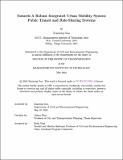Towards A Robust Integrated Urban Mobility System: Public Transit and Ride-Sharing Systems
Author(s)
Guo, Xiaotong
DownloadThesis PDF (36.19Mb)
Advisor
Zhao, Jinhua
Terms of use
Metadata
Show full item recordAbstract
The global pandemic has fundamentally changed lifestyles, impacting how, when, and where people travel within cities. In this post-pandemic world, urban mobility demand patterns are experiencing significant shifts. To manage the growing uncertainty in urban mobility, there is a growing need to develop a robust urban mobility system. This system must be adaptable to evolving demand patterns while ensuring efficiency and environmental sustainability in transporting large populations. Additionally, the increasing popularity of shared mobility and rapid advancements in autonomous driving technologies are creating new opportunities for innovative approaches to urban transportation systems.
This dissertation delves into the development of a robust and integrated urban mobility system for the future, with a focus on the public transit and ride-sharing systems. While the advent of shared mobility platforms such as Uber and Lyft, along with Autonomous Mobility-on-Demand (AMoD) services like Waymo and Cruise, have revolutionized urban travel, public transit systems remain the backbone of urban mobility. This is attributed to their capacity to move large numbers of people over long distances at a relatively low cost and an environmentally friendly way. Thus, this study aims to enhance the robustness of both public transit and ride-sharing systems and explore ways to seamlessly integrate these two components. The dissertation presents five distinct studies to elaborate on these objectives.
The first three studies focus on the vehicle rebalancing problem, which is one of the most critical strategies in ride-sharing operations. An effective rebalancing strategy can significantly reduce empty miles traveled and reduce customer wait times by better matching supply and demand. While the supply (vehicles) is usually known to the system, future passenger demand is uncertain. The first study proposes a novel approach to better immunize rebalancing decisions against demand uncertainty. This approach, namely the matching-integrated vehicle rebalancing (MIVR) model, incorporates driver-customer matching into vehicle rebalancing problems to produce better rebalancing strategies. For further protection against uncertainty, robust optimization (RO) techniques are introduced to construct a robust version of the MIVR model. Problem-specific uncertainty sets are designed for the robust MIVR model. The second study further explores different approaches for handling demand uncertainty in the vehicle rebalancing problem. There are two ways to handle uncertainty. First, the point-prediction-driven optimization framework involves predicting the future demand and then producing rebalancing decisions based on the predicted demand. Second, data-driven optimization approaches directly prescribe rebalancing decisions from data. In this study, a predictive prescription framework is introduced to this problem, where the benefits of predictive and data-driven optimization models are combined.
Although vehicle rebalancing algorithms could improve system efficiency, there exists a detrimental feedback loop where underserved communities with low demand density are unintentionally discriminated. To resolve this fairness issue, the third study develops algorithms for vehicle rebalancing that aim to minimize disparity within the system. Grasping the concept of disparity is a foundation for understanding fairness in the ride-hailing system. The vehicle rebalancing encompasses two critical aspects: upstream demand forecasting and downstream vehicle repositioning. The issues of disparities within both these components are addressed. To reduce disparity in demand prediction, we implement a strategy utilizing a Socio-Aware Spatial-Temporal Graph Convolutional Network (SA-STGCN), aimed at improving demand forecast accuracy while reducing discrepancies in prediction errors across diverse regions. For equitable repositioning of the supply side vehicles, we introduce a disparity-reducing MIVR system. This system is designed to facilitate a balanced vehicle distribution, ensuring that ride-hailing services are accessible equitably across different areas.
The fourth study focuses on the robustness of public transit systems. Limited studies have considered demand uncertainties when designing transit schedules. To better address demand uncertainty issues inherent in public transit systems, this study utilizes the RO framework to generate robust transit schedules against demand uncertainty. A nominal (non-robust) optimization model for the transit frequency setting problem (TFSP) under a single transit line setting is first proposed. The model is then extended to the RO-based formulation to incorporate demand uncertainty. The large-scale origin-destination (OD) matrices for real-world transit problems present computational challenges to solve the optimization problem. To efficiently generate robust transit schedules, a Transit Downsizing (TD) approach is proposed to reduce the dimensionality of the problem.
The last study focuses on the integration of emerging AMoD systems with existing public transit networks. We propose a novel optimization framework to generate the system design of the Transit-Centric Multimodal Urban Mobility with Autonomous Mobility-on-Demand (TCMUM-AMoD) at scale. The system operator (public transit agency) determines the network design and frequency settings of the PT network, fleet sizing and allocations of the AMoD system, and the pricing for using the multimodal system with the goal of minimizing passenger disutility. Passengers' mode and route choice behaviors are modeled explicitly using discrete choice models. A first-order approximation algorithm is introduced to solve the problem at scale. Using a case study in Chicago, we show the potential to generate integrated urban mobility systems in different demand scenarios.
The final chapter summarizes the whole dissertation and outlines potential avenues for future research directions.
Date issued
2024-05Department
Massachusetts Institute of Technology. Department of Civil and Environmental EngineeringPublisher
Massachusetts Institute of Technology